Abstract
This action research is aimed at improving the practice of teacher pedagogy in enhancing the prefix meN- to the Malay language subjects among Year 3 students using the KeGuGan technique. A total of five Year 3 students at one of the primary schools in Ipoh, Perak identified did not master the prefix remuneration of the study. KeGuGan (Kekal-Gugur-Ganti) technique is a graphic map technique that requires students to write the word prefix, meN- in order based on i-Think thinking maps. Instruments for collecting research data involve pre and post-tests, observations, and interviews. The findings show that there is an increase in the percentage of 60% and 70% of student mastery in the prefix meN through the pre and post-tests conducted after intervention using the techniques. While the level of understanding, focus, and involvement of students also increased during teaching and learning sessions through observation. The findings of the interview show that the KeGuGan technique is an easy-to-understand and is used to enhance the student's level of understanding in mastering the prefix meN-. This study shows that the KeGuGan technique is successfully enhancing student mastery and improving the teacher's pedagogical practice in the prefix meN. Such techniques are also in the process of helping Malay language teachers improve the quality of their teaching and learning.
Keywords: KeGuGan techniques, prefix, graphic maps, teacher pedagogical practices
Introduction
The grammatical aspect is one of the language skills that are essential to be understood and learned by the students in the Malay Language subject. The mastery of good grammar can help students to converse with the correct language system and produces quality written literature (Kementerian Pendidikan Malaysia [KPM], 2017). Karim et al. (2015) define grammar as a field that focuses on word formation and the sentence development process of a language. One of the grammatical aspects needed to be mastered by the students is prefixes. According to Abdullah and Yusof (2015), Muhammad and Shari (2020), the prefix is a form of Malay Language morphology that produces derivatives of verbs, besides pluralization and replications of works to increase the value of the Malay vocabulary.
Compared to other word formation processes, the process of affixation is a complex process, as the affixes consist of bounded morphemes that are paired with the basic word to form the derived words. The affixation of the Malay Language vocabulary includes prefixes, suffixes, infixes, and confixes. This research focuses on prefixes, namely the meN- affixation that acts as the prefixes of verbs. Moreover, the Content Standard that is focused on is 5.2 Understanding and usage of word formation according to contexts, meanwhile, the Learning Standard is 5.2.1 Understanding and usage of prefixed adverbs according to contexts (KPM, 2017).
Based on the previous teaching and learning reflections, the researcher identified a few students with a lack of mastery for the prefix concepts, especially the meN- prefix in their writings. This issue can be observed when the students are having difficulties spelling the prefix meN- correctly, namely when writing their sentences. For example, ‘Abang mengunting pokok menggunakan gunting pemangkas’. Based on the sentence before, the correct prefix to be used is the meNG-, forming the word menggunting. Ahamad et al. (2020) state that a student’s weakness in vocabulary caused them to use the wrong affixes that can distort the meanings of the sentences.
On the other hand, the researcher also identified that the student was unsure of the PKTS rule, whereby the rule involves the removal of the first letter of the root word P, K, T, and S when receiving the prefix meN-. For example, in the root word of ‘tolong’ when receiving the prefix of meN-, the letter ‘T’ was removed and replaced with the letter ‘N’, forming the word menolong. This factor can cause confusion and a lack of understanding of the correct affixation usage, leading to writing inaccurate prefixes (Narayanan & Subramaniam, 2021). In addition, the researcher also observed passive participation and lack of attention by students toward their teachers during learning sessions. This can be derived to be caused by the lack of application of Pendidikan Abad Ke-21 (PAK21) strategies and teaching methods by the teacher, causing the lack of interest from the students. Therefore, the teachers should choose appropriate strategies and techniques to nurture excitement in the students during classes (Razak & Mahamod, 2021).
To understand and prove the issue faced by the students in understanding the prefix meN-, the researcher performed an initial survey to collect data using three methods, which are document analysis, observations, and written diagnostic tests. From the initial survey, it is found that students had problems understanding the prefix meN- and the general rule of PKTS. As evidence, as many as eight students earned grades D and E. Meanwhile, the most common grade received by the students was the C grade, with nine students obtaining the grade.
Based on the work done by the students, the researcher detected a few students wrongly wrote the prefix meN- especially in sentence formation such as portrayed in Figure 1. Then, the researcher also performed structural observation of five aspects. Based on the instrument of observation, a number of students could not identify and write the prefix meN-. Furthermore, the students gave minimal attention to their teachers and lacks interest in their learning sessions. Consequently, the researcher suggests one technique known as KeGuGan (Kekal, Gugur, Ganti) to overcome the problems faced by the students when writing the prefix meN- correctly.
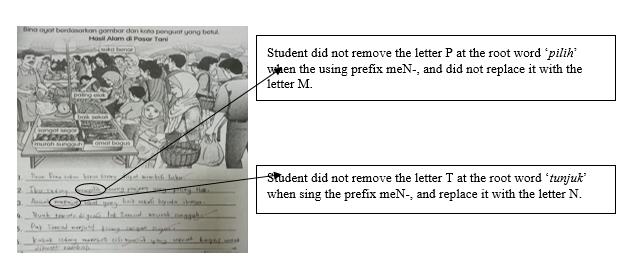
Problem Statement
The focus of this action research is to increase the mastery of meN- prefixes among year 3 students in Sekolah Kebangsaan Bandar Baru Putera, Ipoh, Perak. The researcher made this issue a research question after observing most students’ lack of mastery in the usage of meN- prefix, especially when involving the PKTS rule. Students would inaccurately use the meN- in sentence writing causing their sentences to be wrong and grammatically incorrect which can affect their marks in writing (Mokter, 2019). Hence, the researcher introduced the KeGuGan technique, which is a graphical map that had been adapted based on the i-Think flowchart to aid the students use the prefix meN- correctly. The researcher chose the i-Think map as the main idea to produce this technique due to its short, concise, and attractive nature, which can ease the process of students effectively understanding the information given (Baker & Mohammad, 2021).
This research focus is chosen based on a few criteria such as manageability, importance, usability, control, collaboration, and relevance to schools. From the manageability perspective, the researcher developed the KeGuGan technique to overcome the problem of meN- prefix incorrect usage among students. In addition, this technique has high manageability because the researcher is able to use a multitude of methods to collect the data to display its effectiveness towards student learning. For example, methods such as observation, pre-test post-test, and interviews. From the importance standpoint, this research can increase the understanding of students regarding the usage of meN- prefix when learning vocabulary, especially in which involves the PKTS rule through the KeGuGan technique. Thus, teachers can apply the KeGuGan technique during their teaching and learning sessions as a teaching aid.
Besides that, this research has high usability, meaning that teachers can apply this technique in grammatical subjects and other language skills. Teachers can utilize the KeGuGan technique to teach students from different classes that are facing a similar problem with the usage of meN- prefixes. The next criteria are the control whereby the researcher performed the KeGuGan to assist the students in remembering and forming new prefixes. The researcher constructed interactive multimedia ‘Pengembaraan Imbuhan’ to explain the KeGuGan technique effectively and provide interactive training to attract the student’s interest in learning.
From a collaborative standpoint, this research was done collaboratively by the researcher with the management of the school and fellow teachers. The researcher had discussed with counselors to acquire background information on Year 3 Gamma students, and the problems they face during class. Next, the researcher also cooperated with lecturers as a source of reference to discuss the issue faced when conducting this action research. Last but not least, this action research is relevant to schools through the usage of KeGuGan technique which can increase the mastery of meN- prefix application among students, and be the point of reference for teachers when applying KeGuGan during teaching and learning sessions.
Research Questions
General Objectives
This research was performed to help in increasing the mastery of meN- prefix usage using KeGuGan techniques among Year 3 students.
Specific Objectives
Specifically, the research objectives are:
Identifying if the KeGuGan technique can increase the mastery of meN- prefix among Year students.
Finding out if KeGuGan technique used in the pedagogical practices of teachers can increase the mastery of meN- prefix among Year 3 students.
Research Questions
This research intends to answer the questions:
Are the KeGuGan technique able to increase the mastery of the meN- prefix among Year 3 students?
Are the usage of the KeGuGan technique able to improve the pedagogical practices of teachers in increasing the mastery of the meN- prefix among Year 3 students?
Research Methods
This action research is based on Kurt Lewin’s Research Model for overcoming the issues faced by students based on the proposed actions that have been planned. According to Lewin (1946), action research shows a cycle of steps that has four steps, namely planning, action, observing, and reflecting. Figure 2 showed the steps taken based on the Kurt Lewin Research Model to solve the student’s problems in mastering the prefix usage of meN-.
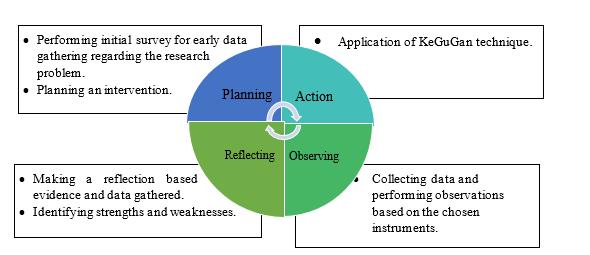
Research participants
The researcher chose the Year 3 students from 3 Gamma from Sekolah Kebangsaan Bandar Baru Putera, Ipoh, Perak as research participants. Out of 25 students, five students were chosen. The research participants consist of two male students and three female students, all the participants are Malays. The level of academic achievement for the five research participants is at a weak level in the Malay Language subject. Based on the diagnostic test, all five research participants were not able to correctly use the prefix meN-, and often face confusion when using the prefix when writing a sentence.
Research implementation
Consequently, the researcher has implemented actions after identifying the student's problem by using KeGuGan technique to help Year 3 students master writing meN- prefix, especially involving the PTKS rule. Figure 3 shows the steps taken by the researcher to perform this study. On the other hand, Figure 4 shows the explanation of KeGuGan Technique.
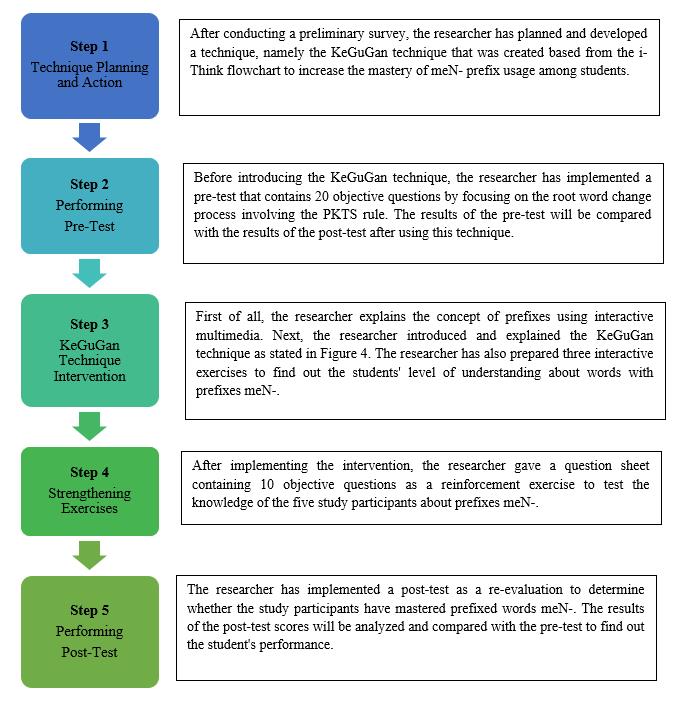
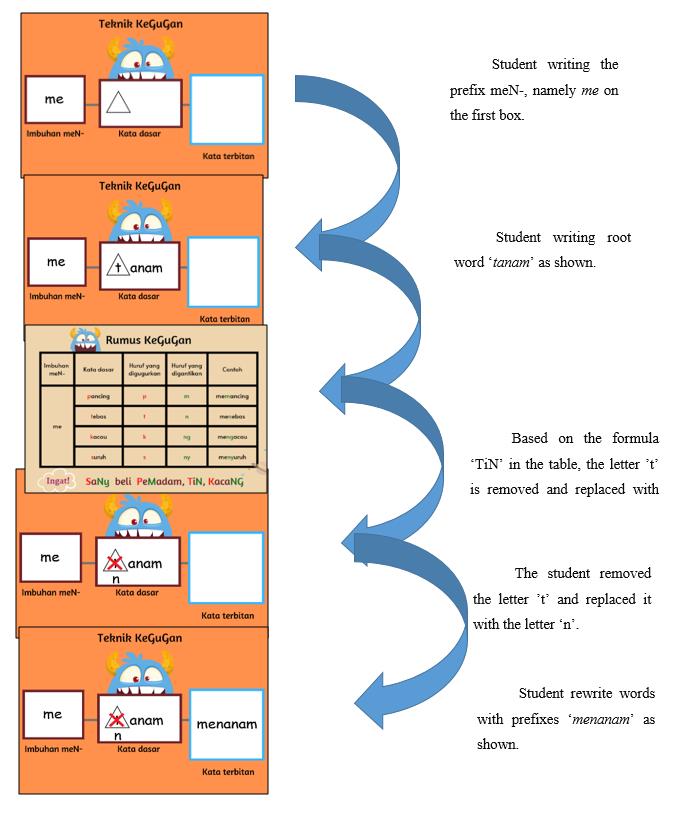
Data collecting method
The researcher used three methods to collect the data needed, which are the pre-test and post-test, structural observation, and interviews to measure the desired research objectives. To answer the first research objectives, the researcher used a pre-test, post-test, and observation methods. Before introducing the KeGuGan technique, the researcher conducted a pre-test on the five research participants, while the post-test was conducted after the intervention was implemented. In addition, the researcher has used the observation method using a checklist form to see the skills of the study participants in producing prefixed adverbs meN- and students’ behaviors during teaching and learning sessions. Meanwhile, the researcher has also used interview methods with Malay Language teachers and research participants by preparing questions to answer the second research objective.
Data analyzing method
Next, in order to analyze the data from the two tests, the researcher has determined the students' marks according to the marking scheme by referencing School Examination Analysis System. Later, the researcher presented the data in the form of a bar chart graph to show the comparison of pre-test and post-test score results using the percentage of correct answers. In addition, the researcher has analyzed each aspect listed in the Yes-No observation checklist form using percentages.
Test results and observations are used to determine whether the use of the KeGuGan technique can increase the mastery of Year 3 students in the usage of meN- prefix. Furthermore, the researcher has also analyzed each data obtained from the interview using the transcription of the interview using a thematic approach. Interview findings obtained from teachers and research participants can determine whether the KeGuGan technique can improve teachers' pedagogical practices in increasing mastery of prefixes meN-.
Data checking method
The researcher has used data triangulation between methods to check the study data by using various methods such as pre-test and post-test, structured observation, and structured interview as an instrument to collect data. The methods used can determine the validity of the data collected and obtained by the researcher by comparing data from various sources.
Findings
Pre-Test and Post- Test Result
Based on the results of the scores of the two tests that have been collected, the researcher has analyzed by comparing the scores to see the effectiveness of the intervention carried out on the performance of the study participants as shown in Figure 5.
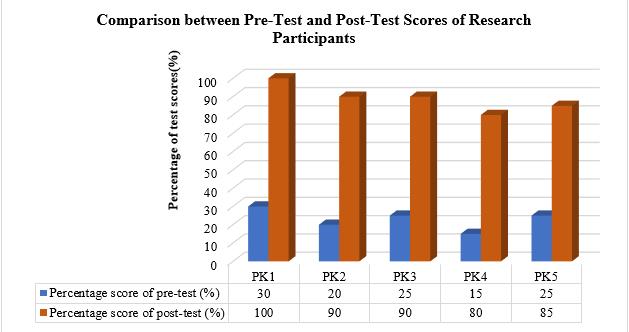
Based on the comparison of these two tests, it was found that the percentage of a test score increased in the range of 60% to 70%. For PK1 and PK2, the increase in score is as much as 70%. On the other hand, PK3 and PK4 experience an increase of as much as 65%. Finally, PK5 had an improved score of up to 60%. Based on the findings of this study, the researcher found that 100% of the study participants had achieved an excellent level of mastery and obtained an A grade in the post-test compared to the results of the pre-test.
Observation
To test the level of effectiveness of the KeGuGan technique introduced to the five research participants, the researcher conducted a structured observation using a Yes-No observation checklist form based on five question items. The results of the observation are shown in Table 1.
Based on Table 1, aspect 1, aspect 2 and aspect 5 show the frequency of the same 'Yes' item which is 5 which represents 100%. Next, aspect 3 shows the frequency of the 'Yes' item which is 4 which represents 80%, and the 'No' item which represents 20% by 1. In addition, aspect 4 shows the frequency of the 'Yes' item by 3 which represents 60% and the item ' No' represents 40% of 2. Overall, the five study participants were able to answer all the meN- prefix questions given using the KeGuGan technique because they were able to understand how to use this technique during the meN- prefix teaching. The results of the pre-test, post-test, and observation have answered the objectives of the first study.
Interview
The researcher used an interview instrument with the five study participants and a Malay Language subject teacher to answer the objectives of the second study. Based on the transcription of the interviews that have been conducted, the researcher has categorized and coded the interview data according to the appropriate themes as shown in Table 2.
Based on Table 2, the teacher and the five research participants agreed that the KeGuGan technique is an interesting and fun technique under the code/theme of 'fun' because this technique is integrated with interactive multimedia elements and cartoon characters that interest the students. Moreover, the researcher also found that this KeGuGan technique is easy to understand. The evidence is that the five research participants and teachers stated that this technique is easily mastered by the students to write words with the prefix meN- correctly. Next, the teacher and the five participants of the study were also of the opinion that this KeGuGan technique is suitable to be used as fuel to improve teachers' pedagogical practices. This statement is proven when this technique can help students write words with the prefix meN- and is suitable for use by teachers when conducting teaching and learning sessions. In conclusion, the results of the interviews have answered the objectives of the second study.
Conclusions
Based on the research findings obtained, it can be concluded that the KeGuGan technique can help students improve their mastery of the prefix meN-. This can be proven based on the post-test results of the five research participants who showed a significant improvement after undergoing the intervention. During the implementation of this study, there are several strengths that have been identified, which are the application of entertaining educational elements such as storytelling techniques and elements of laughter when implementing interventions for research participants. The fun education approach makes the learning session more relaxed and fun, leading students to be motivated to learn (Unjong & Seruji, 2022). Next, the perceived strength, which is the application of ICT elements by using interactive multimedia to attract students' interest to follow the intervention introduced. The application of information and communication technology (ICT) elements is very important in teaching and learning sessions so that it is more interesting and effective and can improve the quality of teachers' teaching (Zakaria et al., 2017).
The next strength that is seen is the KeGuGan technique formula that was created can increase students' mastery of the prefix meN-. This formula is constructed to make it easier for students to remember the letters that need to be dropped and replaced when a base word starts with the letters P, K, T, and S combined with the prefix meN-. Jamil and Halim (2018) stated that the usage of formulas in learning can increase students' memory to master a topic faster. The proof is that students make fewer mistakes in writing with the prefix meN-, which is proven through the results of the post-test that has been performed.
Recommendations
The researcher has listed some suggested follow-up actions that can be used as a reference for the next researcher if this kind of study is carried out in the future. The first suggestion is that the researcher plans to include entertainment education elements such as singing techniques when delivering the KeGuGan technique formula, namely. Music is strongly encouraged because it can create a fun learning atmosphere to attract the interest of students in teaching and learning sessions, to be able to follow the planned learning and then achieve the learning objectives (Abdullah & Mohammad, 2022; Salleh & Zulkifli, 2020).
Next, the researcher plans to improve the interactive multimedia elements used in the KeGuGan technique such as including background music and explanatory videos of the KeGuGan technique. The use of interactive multimedia elements in teaching and learning sessions can help students to concentrate, and easily understand the learning content presented (Ibrahim et al., 2021). This makes the learning atmosphere more fun and interesting for the students during class. Therefore, the use of interactive multimedia elements is essential to increase students' intrinsic knowledge and motivation, so that they can pay attention to the conducted class (Ismail & Khalib, 2020).
Consequently, the researcher hopes to increase the number of study participants, in order to bring benefits from this study to more students who are weak in mastering the prefix meN-. Furthermore, the researcher also plans to expand this technique for Level 1 and Level 2 students because this topic is very important to master, especially to write sentences with correct grammar. Nasir (2017) explained that students need to master the types and functions of prefixes so that they can write them correctly and not affect the meaning of the sentence they want to convey. The researcher also plans to carry out this study by selecting study participants consisting of various ethnicities to see the suitability of the KeGuGan technique to help students improve their mastery of words with the prefix meN-. Finally, the researcher also intends to introduce this KeGuGan technique to fellow teachers and other schools through educational webinars, such as YouTube and Google Sites. Through this partnership, teachers can improve their pedagogical practices by modifying this technique in accordance with the suitability of their grammar classes.
References
Abdullah, I. H., & Yusof, H. (2015). Produktiviti imbuhan mem-, memper- dan memper-kan: Pendekatan linguistik korpus [Productivity of the affixes mem-, mem- and mem-kan: A corpus linguistics approach]. Jurnal Bahasa, 15(1), 41-62. http://jurnal.dbp.my/index.php/jurnalbahasa/article/view/4258/1383
Abdullah, S. A. S. A., & Mohammad, W. M. R. W. (2022). Cabaran pengaplikasian pendekatan didik hibur dalam pengajaran guru Bahasa Melayu dari aspek kemahiran membaca dalam talian [The challenge of applying didik hibur approach in the teaching of Malay teachers from the aspect of online reading skills]. Jurnal Dunia Pendidikan, 4(1), 349-362. http://myjms.mohe.gov.my/index.php/jdpd
Ahamad, N. A., Rusli, N. F. M., & Jobar, N. A. (2020). Analisis kesalahan imbuhan dalam penulisan karangan pelajar dan hubung kait dari segi makna gramatikal [Analysis of affix errors in student essay writing and correlation in terms of grammatical meaning]. Jurnal Pendidikan Bahasa Melayu, 10(1), 77-90.
Baker, Z. A., & Mohammad, W. M. R. W. (2021). Keberkesanan penggunaan kaedah peta I-Think dalam kalangan guru senior Bahasa Melayu sekolah kebangsaan di daerah Seremban [The effectiveness of using the I-Think map method among senior Malay teachers of national schools in the Seremban district]. Jurnal Dunia Pendidikan, 3(2), 32-43. https://myjms.mohe.gov.my/index.php/jdpd/article/view/13496/6915
Ibrahim, N. F. S. C., Rusli, N. F. M., Shaari, M. R., & Nallaluthan, K. (2021). Persepsi pelajar terhadap aplikasi multimedia interaktif dalam proses pengajaran dan pembelajaran abad ke-21 [Student perception of interactive multimedia applications in the teaching and learning process of the 21st century]. Online Journal for Tvet Practitioners, 6(1), 15-24.
Ismail, F. M., & Khalib, T. N. T. M. (2020). Penggunaan ICT dalam pembelajaran interaksi lisan [The use of ICT in learning oral interaction]. Muallim Journal of Social Science and Humanities (MJSSH), 4(2), 137-149.
Jamil, U. F. M., & Halim, F. A. (2018). Kaedah mnemonik akronim dalam mata pelajaran Reka Bentuk dan Teknologi di Sekolah Rendah Agama Bersepadu Mersing [Acronym mnemonic method in Design and Technology subjects at Mersing Integrated Religious Primary School]. Online Journal for TVET Practitioners, 3(1), 1-9.
Karim, N. S., Onn, F. M., Musa, H., & Mahmood, A. H. (2015). Tatabahasa Dewan [Book of Malay Grammar]. Dewan Bahasa dan Pustaka.
Kementerian Pendidikan Malaysia. (2017). Dokumen Standard Kurikulum dan Pentaksiran Bahasa Melayu Sekolah Kebangsaan Tahun 3. Kurikulum Standard Sekolah Rendah [National School Malay Language Assessment and Curriculum Standard Document Year 3. Primary School Standard Curriculum]. Pusat Perkembangan Kurikulum.
Lewin, K. (1946). Action research and minority problems. Journal of social issues, 2(40), 34-36.
Mokter, F. A. (2019). Keberkesanan pembelajaran berasaskan masalah terhadap pencapaian dan kemahiran berfikir aras tinggi pelajar dalam penulisan karangan Bahasa Melayu [The effectiveness of problem-based learning on the achievement and high-level thinking skills of students in Malay essay writing]. Jurnal Pendidikan Bahasa Melayu [Malay Language Education – MyLEJ], 9(1). 33-46. http://journalarticle.ukm.my/14522/1/191-366-1-SM.pdf
Muhammad, S. R., & Shari, S. N. (2020). Kesalahan tatabahasa Bahasa Melayu dari aspek morfologi dalam penulisan karangan murid sekolah rendah [Malay grammar mistakes from the morphological aspect in the writing of primary school students' essays]. International Sosial Science and Humanities Journal, 3(2), 77-89.
Narayanan, N. S. P., & Subramaniam, V. (2021). Pembangunan kit inovasi berimbuhan bagi murid sekolah rendah [Development of an innovation kit for primary school students]. Jurnal Melayu, 395-410.
Nasir, Z. M. (2017). Kesalahan tatabahasa Bahasa Melayu dalam penulisan karangan pelajar (Malay grammar mistakes in students’ essays). LSP International Journal, 4(1), 23-35.
Razak, A. A., & Mahamod, Z. (2021). Strategi pembelajaran Bahasa Melayu dalam aspek tatabahasa pelajar Tingkatan Enam [Malay language learning strategies in the grammar aspects of Form Six students]. Jurnal Dunia Pendidikan, 3(1), 299-309. https://myjms.mohe.gov.my/index.php/jdpd/article/view/12582/6300
Salleh, M. R. M., & Zulkifli, H. (2020). Penggunaan didik hibur dalam Pendidikan Islam Sekolah Kebangsaan [The use of didik hibur in the Islamic Education of the National School]. Malaysian Online Journal of Education, 4(2), 1-16. https://attarbawiy.kuis.edu.my/index.php/jurnal/article/view/36/26
Unjong, P., & Seruji, Z. (2022). Pelaksanaan didik hibur dalam pengajaran dan pembelajaran membaca Bahasa Melayu murid Linus Tahun 3 [The implementation of didik hibur in teaching and learning to read Bahasa Melayu for Year 3 Linus students]. Asian People Journal, 5(1), 22-30. https://journal.unisza.edu.my/apj/index.php/apj/article/view/270/208
Zakaria, S., Hamzah, M. I., & Razak, K. A. (2017). Penggunaan ICT dalam pengajaran dan pembelajaran pensyarah Pendidikan Islam di Politeknik zon selatan [The use of ICT in the teaching and learning of Islamic Education lecturers at the South Zone Polytechnic]. Tinta Artikulasi Membina Ummah, 3(1), 29-41. http://www.journaltamu.com/wp-content/uploads/2017/07/TAMU-Vol-31-June-2017-3.pdf
Copyright information

This work is licensed under a Creative Commons Attribution-NonCommercial-NoDerivatives 4.0 International License.
About this article
Publication Date
25 September 2023
Article Doi
eBook ISBN
978-1-80296-964-1
Publisher
European Publisher
Volume
7
Print ISBN (optional)
-
Edition Number
1st Edition
Pages
1-929
Subjects
Language, education, literature, linguistics
Cite this article as:
Aziz, N. K. M. B., & Yusof, F. H. B. M. (2023). Usage of Kegugan to Increase Mastery of Prefixes Among Year Three Pupils. In M. Rahim, A. A. Ab Aziz, I. Saja @ Mearaj, N. A. Kamarudin, O. L. Chong, N. Zaini, A. Bidin, N. Mohamad Ayob, Z. Mohd Sulaiman, Y. S. Chan, & N. H. M. Saad (Eds.), Embracing Change: Emancipating the Landscape of Research in Linguistic, Language and Literature, vol 7. European Proceedings of Educational Sciences (pp. 401-413). European Publisher. https://doi.org/10.15405/epes.23097.36

